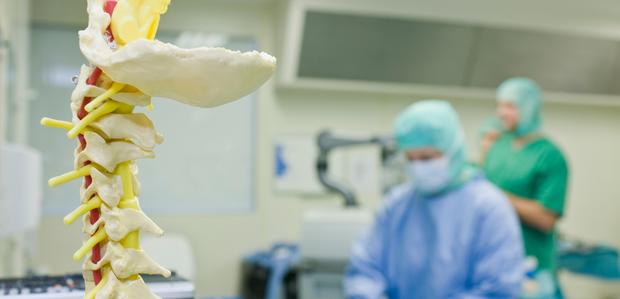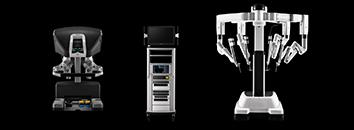Department of Neuro And Spine Surgery

At the Institute of Spine and Neurosurgery at Gleneagles Hospitals, consultants are trained to treat people with Brain, Spine and Nervous System (Neurologic) conditions. Spine and Neurosurgery is a special medical branch that is solely concerned with the prevention, diagnosis, treatment, and recuperation of conditions which affect any portion of the nervous system such as the Brain, Spinal Cord, Peripheral Nerves and Extra-cranial Cerebrovascular System.
The department performs over 1,000 procedures each year. We have a dedicated team of surgeons who have undergone training from top-class faculty of reputed institutions. With an established and well-equipped lab, with the latest technological equipment for the diagnosis and treatment of patients, we aim to provide the best care in India.
The Spine and Neurosurgery division is equipped with dedicated state-of-the-art operating rooms with good infrastructure, exclusive intensive surgical wards and have established rehabilitation centre for post-operative patient care. Every test and procedure performed is well organised and the results are accurate; it is the togetherness of the team that brings out great results.
- By providing excellent clinical and compassionate care, we protect the health and well-being of our patients to help them lead healthy lives.
PROCEDURES
ANTERIOR CERVICAL DISCECTOMY AND FUSION (ACDF)
Anterior Cervical Discectomy and Fusion (ACDF) is a surgical procedure to remove the degenerative disc in the neck area of the spine. It is also used to treat serious pain from a nerve root that has become inflamed. The treatment is performed by decompressing the spinal cord and nerve roots. ACDF procedure is used when other non-surgical treatments have failed.
The patient is asked to change into a hospital gown. The surgeon makes an incision in the throat area to reach the front of the spine. A graft is inserted by removing the disc. The graft is inserted to fuse the bones present above and below the disc. The doctor recommends this surgery when the physical therapy and medications fail to relieve the pain in the neck or arm. Patients are sent home the same day. It may take 3-4 weeks for the person to recover completely.
LUMBAR LAMINECTOMY
Lumbar Laminectomy is a surgical procedure of the back to relieve the compression of the spinal cord. The doctor removes the lamina which adds pressure on the spinal cord or nerve roots. The lamina is part of the bone that forms the vertebral arch in the spine. Added pressure on the spinal cord causes mild to severe back pain, difficulty in walking, weakness or numbness in the legs and also causes difficulty controlling the bladder or bowel movements.
The patient will be asked to lie down on the abdomen, in a kneeling position to reduce the weight of the abdomen on the spine. The surgeon will make a straight incision from the desired vertebrae to the lamina which is present down. He then removes the lamina and sets the nerve root back toward the centre of your spinal column. He also removes the disc. The surgery takes about 2-3 hours to complete.
CRANIOTOMY
A craniotomy is the surgical removal of a section of the skull to access the intracranial compartment. It is commonly performed to remove the brain tumour. It is also performed to remove a blood clot (hematoma), control haemorrhage, repair arteriovenous malformations (abnormal connections of blood vessels), relieve pressure inside the skull, drain a brain abscess, perform a biopsy, or inspect the brain.
The surgeon makes an incision either around the occipital bone at the nape of the neck or a curved incision above the ear and eye. Once the incision is made on the skin, muscles and tissues of the scalp are folded back and the skull is exposed. Small holes are drilled into the skull. The bone flap is then removed to expose the brain tissues for the surgeon to perform the surgery. After the surgery, the bone flap is put back in place. The incision is finally covered with a bandage. It takes about 4-6 hours to complete the surgery.
CHIARI DECOMPRESSION
Chiari decompression is used to treat Arnold-Chiari malformation. This condition produces an inability to properly balance. Chiari decompression involves removing a bone in the back of the skull to widen the foramen magnum. This, in many cases, helps improve balance and coordination.
LUMBAR PUNCTURE
A lumbar puncture, which is also called a spinal tap, is one of the simpler (yet still relatively complex) neurosurgery procedures. It is a diagnostic procedure that is performed to determine if the patient has signs of any conditions related to the central nervous system. It is overall a safe surgery when performed by an experienced neurologist, and the risks are minimal.
EPILEPSY NEUROSURGERY
Epilepsy neurosurgery is for individuals with epilepsy. Specifically, this procedure is for those who have severe epileptic seizures and have not found relief through non-surgical treatments. Most often, neurologists recommend medications to deal with epilepsy and related seizures. If this does not work, however, epilepsy neurosurgery may be needed, which involves removing or modifying the part of the brain that is producing severe and potentially fatal seizures
SCOLIOSIS SURGERY
Scoliosis is the abnormal curvature of the Spine. Scoliosis surgery involves correcting the deformed curvature of the Spine. With the advanced tools and technology, the surgeons at Gleneagles Hospitals can improve their curves significantly. The procedure involves spinal fusion where the curved Vertebrae are realigned and fused into a single and solid bone.
The procedure is performed under general anaesthesia. During the procedure, the incision is made in the back of the pine. Then the muscles are stripped off to access the bone elements of the Spine. Metal screws and rods are used to reduce the amount of curvature. Bone grafts are used to incite the reaction where the bones in the Spine fuse together.
KYPHOPLASTY
Kyphoplasty is a minimally invasive surgical procedure indicated in patients with Kyphosis. Kyphosis is an outward curvature of the Spine and for the treatment of fractured Vertebrae. The procedure involves injecting special cement into the Vertebrae by creating a space with a balloon-like device.
Local or general anaesthesia is administered before the procedure. In kyphoplasty, a needle is inserted into the affected bone through the skin with X-ray guidance. Then, a balloon-like device is inflated allowing the Vertebrae to regain its normal shape. The space created is filled by injecting special cement.
WAYS TO CALM YOUR NERVES
BREATHE: The simplest way to reduce anxiety is to breathe. Deeper and slower breathing helps relieve stress as more oxygen is allowed into the system.
RIGHT FOOD: In times of stress, it is natural to crave junk food; but this will increase the blood-sugar level making you feel even more jittery. Instead, snack on healthy foods like carrots, cucumber etc.
SOAK UP IN THE SUN: Research has proven that exposure to sunlight can relieve stress. Research has also shown that people when placed in bright rooms were reported to be less stressed when compared to dim rooms.
LISTEN TO SLOW MUSIC: Listening to slow music calms your nerves, reduces stress, and blood pressure and also reduces heart rate.
SMELL CITRUS: The scent of citrus boosts feelings of well-being and relaxes the nerves thereby, relieving stress and anxiety.
GO FOR A WALK: Walking can help reduce stress because it produces chemicals in the brain that act as natural painkillers. It helps you get proper sleep and thus relieves further stress.
WAYS TO KEEP YOUR SPINE HEALTHY
SLEEP TIGHT: Sleeping position and the mattress can greatly affect the Spine. Your body requires sleep to rejuvenate itself. Avoid sleeping on the stomach as it may apply too much pressure on your Spine. The use of a supportive mattress and a pillow promotes the proper alignment of the neck. Turning the mattress regularly will make it wear off evenly.
STAY ACTIVE: Being active and regular exercise strengthens bones and muscles which support your Spine. Exercise also helps to maintain a healthy body weight. Being overweight, especially the presence of belly fat can add stress to your muscles, ligaments, and tendons in the lower back.
PRACTICE GOOD ERGONOMICS: Practising good posture while sitting and standing plays an important role in supporting the natural curves of the back. Proper ergonomics also reduces stress on the upper and lower back.
STAY HYDRATED: Drinking adequate fluids is important to maintain soft tissue elasticity and fluidity in the joints. Dehydration causes the Spinal discs to shrink leading to painful disc conditions such as ruptures or bulging.
Our Doctors
View all-

Dr Nigel Symss
Senior Consultant Neurosurgeon
MBBS, DNB (Neurosurgery)
-

Dr Venkatesh Y
Chief Consultant Neurosurgeon
MBBS, MD & MCh - Neuro Surgery & MS - General Surgery
-

Dr Nitin Dange
Head Of Department
MBBS, MS, M.Ch, OBNI-USA, FFHU-JAPAN
-

Dr Naveen M A
HOD & Sr Consultant - Neuro & Spine Surgery
MBBS, MS (Gen Surgery), MCh (Neurosurgery), FMAS, FMISS (Seoul)
-

Dr Kalyan Chakravarthy N
Consultant
M.B.B.S, M.S (General Surgery), M.Ch (Plastic Surgery)
BRINGING THE LATEST TECHNOLOGIES FROM AROUND THE GLOBE FOR ACCURATE DIAGNOSIS AND TREATMENT OF DISEASES
The Department of Neuro And Spine Surgery at Gleneagles Hospitals offers advanced surgical interventions for the treatment and management of neurological disorders. A team of highly specialised surgeons employ minimally invasive methods to ensure that the patient suffers from as little trauma as possible. Employing some of the top neurologists and neurosurgeons the departments strive for the comprehensive diagnosis, treatment and management of all neurological conditions. The Department of Neurosurgery offers surgical interventions for the following common diseases and conditions among many others:
- What causes a Cerebral Aneurysm?
Aneurysms often form at the branches of the arteries as those sections of the vessels are weaker and commonly occur in arteries at the base of the brain. Aneurysms develop due to thinning of arterial walls.
- Are there any warning signs of a Cerebral Aneurysm?
Signs & Symptoms of cerebral aneurysm are Sudden and severe headache, Double vision, Nausea and vomiting, Loss of consciousness, Change in mental status, Seizures (rare), Risk factors
FAQ
Why Choose Us?
-
PATIENT EXPERIENCE
Your care and comfort are our top priorities. We ensure that the patients are well informed prior to every step we take for their benefit and that their queries are effectively answered.
-
LATEST TECHNOLOGIES
The Gleneagles Hospitals' team stays up to date on the advancements in medical procedures and technologies. Experience the Future Healthcare Technologies now at Gleneagles Hospitals.
-
PROVIDING QUALITY CARE
Strengthening lives through compassionate care, innovative therapies and relentless efforts. It reflects in the DNA of our passionate team of doctors and dedicated clinical staff.










